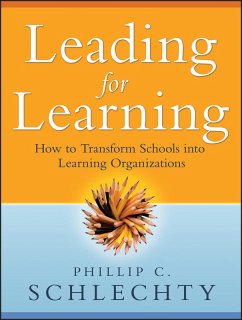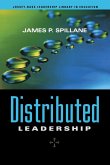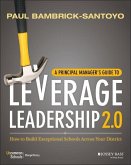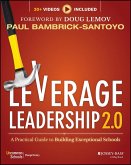Phillip C. Schlechty (Schlechty Center for Leadership in School Ref
Leading for Learning
17,99 €
inkl. MwSt.
Versandfertig in 2-4 Wochen

9 °P sammeln
Phillip C. Schlechty (Schlechty Center for Leadership in School Ref
Leading for Learning
- Broschiertes Buch
- Merkliste
- Auf die Merkliste
- Bewerten Bewerten
- Teilen
- Produkt teilen
- Produkterinnerung
- Produkterinnerung
How do schools compete with television, computer games, and the Internet to engage the hearts and minds of their students? Phil Schlechty argues that we must develop schools where innovation is encouraged, and students are given work that is truly rigorous, relevant, and exciting.
Andere Kunden interessierten sich auch für
![Distributed Leadership Distributed Leadership]() James P. Spillane (Northwestern University)Distributed Leadership35,99 €
James P. Spillane (Northwestern University)Distributed Leadership35,99 €![A Principal Manager's Guide to Leverage Leadership 2.0 A Principal Manager's Guide to Leverage Leadership 2.0]() Paul Bambrick-SantoyoA Principal Manager's Guide to Leverage Leadership 2.034,99 €
Paul Bambrick-SantoyoA Principal Manager's Guide to Leverage Leadership 2.034,99 €![Teaching As Leadership Teaching As Leadership]() Teach For AmericaTeaching As Leadership20,99 €
Teach For AmericaTeaching As Leadership20,99 €![Mentoring Teachers Mentoring Teachers]() Ann LiebermanMentoring Teachers21,99 €
Ann LiebermanMentoring Teachers21,99 €![Student-Centered Leadership Student-Centered Leadership]() Viviane RobinsonStudent-Centered Leadership37,99 €
Viviane RobinsonStudent-Centered Leadership37,99 €![What School Leaders Need to Know About Digital Technologies and Social Media What School Leaders Need to Know About Digital Technologies and Social Media]() What School Leaders Need to Know About Digital Technologies and Social Media29,99 €
What School Leaders Need to Know About Digital Technologies and Social Media29,99 €![Leverage Leadership 2.0 Leverage Leadership 2.0]() Paul Bambrick-SantoyoLeverage Leadership 2.037,99 €
Paul Bambrick-SantoyoLeverage Leadership 2.037,99 €-
-
-
How do schools compete with television, computer games, and the Internet to engage the hearts and minds of their students? Phil Schlechty argues that we must develop schools where innovation is encouraged, and students are given work that is truly rigorous, relevant, and exciting.
Hinweis: Dieser Artikel kann nur an eine deutsche Lieferadresse ausgeliefert werden.
Hinweis: Dieser Artikel kann nur an eine deutsche Lieferadresse ausgeliefert werden.
Produktdetails
- Produktdetails
- Verlag: John Wiley & Sons Inc
- Seitenzahl: 352
- Erscheinungstermin: 1. April 2009
- Englisch
- Abmessung: 234mm x 175mm x 28mm
- Gewicht: 528g
- ISBN-13: 9780787994341
- ISBN-10: 0787994340
- Artikelnr.: 25834308
- Herstellerkennzeichnung
- Libri GmbH
- Europaallee 1
- 36244 Bad Hersfeld
- gpsr@libri.de
- Verlag: John Wiley & Sons Inc
- Seitenzahl: 352
- Erscheinungstermin: 1. April 2009
- Englisch
- Abmessung: 234mm x 175mm x 28mm
- Gewicht: 528g
- ISBN-13: 9780787994341
- ISBN-10: 0787994340
- Artikelnr.: 25834308
- Herstellerkennzeichnung
- Libri GmbH
- Europaallee 1
- 36244 Bad Hersfeld
- gpsr@libri.de
The Author PHILLIP C. SCHLECHTY is founder and CEO of the Schlechty Center for Leadership in School Reform. Schlechty is the author of Creating Great Schools, Working on the Work, Inventing Better Schools, Shaking Up the Schoolhouse, and Schools for the 21st Century.
Preface ix
The Author xix
Part One Making the Case for Transformation 1
One: The Case for Transformation 3
Why Reformation is Not Enough 4
The Need for Transformation 5
Why We Tinker: The Problem Defined 19
Two: Systems and Technological Change 23
Understanding Schools as Complex Social Organizations 25
The Nature of Systemic Change 26
Disruptive and Sustaining Innovations 27
Critical Social Systems 29
Why Reform is So Difficult 31
Common Language, Power, and Separation 38
Three: Bureaucracies Versus Learning Organizations 39
Ideal Types: A Tool for Analysis 40
How is Social Control Established? 50
What is the School's Function? 61
Images of School 68
Four: Bureaucratic Images of Schools 69
About the Metaphors 70
A Basic Framework 71
The School as Factory 74
The School as Professional Service Delivery Organization 87
The School as Warehouse or Prison 99
Getting the Problem Right 110
Five: A New Image of Schools 113
Learning Organization or Learning Community? 113
Transmitting the Knowledge Work Culture 123
The School as a Small Community or a Family 134
Critical Steps to Transformation 138
Part Two Getting Our Bearings: The Sociopolitical Landscape 141
Six: The Bureaucratic Impulse 143
Historic Roots 143
From Community Institutions to Government Agencies 148
The Consequences of Bureaucratization 153
The Need for Grassroots Action 156
Seven: Reassessing Standards 159
An Upstream Struggle 160
The Profit Motive 161
Who Are the Customers? 164
The Meaning of Standards 169
The Trivialization of Standards 170
No Tests for Standards 172
The Effects of Standards 173
Different Constituencies, Differing Standards 180
Eight: Restoring Civic Capacity and Building Social Capital: Two Keys to
School Transformation 187
Schooling and the Decline of Communities 188
The Need for Community Building 191
Politics, Economics, and the Moral Order of Communities 193
The Need for School Board Leadership 195
Public Education as a Moral Imperative 199
Building Social Capital 201
Can It Be Done? 204
A Concluding Comment 206
Part Three Taking the First Steps: How Transformation Can Happen 207
Nine: Painting a New Image of Schools 209
The Uses of Metaphors and Mental Models 209
Lessons Learned About the Use of Metaphors 216
Selecting Metaphors to Aid in Transformation 218
A Suggested Exercise 219
Other Uses of Metaphors 219
A Concluding Comment 221
Ten: Creating the Capacity to Support Innovation 223
Capacity Building: A Point of View 223
System Capacity Standards 224
Persistence of Effort 238
Eleven: Standards as Sources of Direction 241
Reframing the Problem of Standards 242
Helping Communities Hold Schools Accountable 248
Organizational Performance Standards 253
Some Thoughts on State and Federal Policy 258
Accountability and Equity 259
A Word of Caution 262
Twelve: A Theory of Action 265
First Steps 265
Toward a Theory of Action 271
Subsequent Steps 275
A Theory, Not a Prescription 276
A Closing Comment 278
Thirteen: Engaging the Heart and Recapturing Our Heritage 281
Developing a Marketing Mentality 281
Some Additional Suggestions for Action 284
A Common Cause 287
Appendix A Organizational Properties and Systemic Qualities 289
Appendix B Images of School 307
Bibliography 313
Index 319
The Author xix
Part One Making the Case for Transformation 1
One: The Case for Transformation 3
Why Reformation is Not Enough 4
The Need for Transformation 5
Why We Tinker: The Problem Defined 19
Two: Systems and Technological Change 23
Understanding Schools as Complex Social Organizations 25
The Nature of Systemic Change 26
Disruptive and Sustaining Innovations 27
Critical Social Systems 29
Why Reform is So Difficult 31
Common Language, Power, and Separation 38
Three: Bureaucracies Versus Learning Organizations 39
Ideal Types: A Tool for Analysis 40
How is Social Control Established? 50
What is the School's Function? 61
Images of School 68
Four: Bureaucratic Images of Schools 69
About the Metaphors 70
A Basic Framework 71
The School as Factory 74
The School as Professional Service Delivery Organization 87
The School as Warehouse or Prison 99
Getting the Problem Right 110
Five: A New Image of Schools 113
Learning Organization or Learning Community? 113
Transmitting the Knowledge Work Culture 123
The School as a Small Community or a Family 134
Critical Steps to Transformation 138
Part Two Getting Our Bearings: The Sociopolitical Landscape 141
Six: The Bureaucratic Impulse 143
Historic Roots 143
From Community Institutions to Government Agencies 148
The Consequences of Bureaucratization 153
The Need for Grassroots Action 156
Seven: Reassessing Standards 159
An Upstream Struggle 160
The Profit Motive 161
Who Are the Customers? 164
The Meaning of Standards 169
The Trivialization of Standards 170
No Tests for Standards 172
The Effects of Standards 173
Different Constituencies, Differing Standards 180
Eight: Restoring Civic Capacity and Building Social Capital: Two Keys to
School Transformation 187
Schooling and the Decline of Communities 188
The Need for Community Building 191
Politics, Economics, and the Moral Order of Communities 193
The Need for School Board Leadership 195
Public Education as a Moral Imperative 199
Building Social Capital 201
Can It Be Done? 204
A Concluding Comment 206
Part Three Taking the First Steps: How Transformation Can Happen 207
Nine: Painting a New Image of Schools 209
The Uses of Metaphors and Mental Models 209
Lessons Learned About the Use of Metaphors 216
Selecting Metaphors to Aid in Transformation 218
A Suggested Exercise 219
Other Uses of Metaphors 219
A Concluding Comment 221
Ten: Creating the Capacity to Support Innovation 223
Capacity Building: A Point of View 223
System Capacity Standards 224
Persistence of Effort 238
Eleven: Standards as Sources of Direction 241
Reframing the Problem of Standards 242
Helping Communities Hold Schools Accountable 248
Organizational Performance Standards 253
Some Thoughts on State and Federal Policy 258
Accountability and Equity 259
A Word of Caution 262
Twelve: A Theory of Action 265
First Steps 265
Toward a Theory of Action 271
Subsequent Steps 275
A Theory, Not a Prescription 276
A Closing Comment 278
Thirteen: Engaging the Heart and Recapturing Our Heritage 281
Developing a Marketing Mentality 281
Some Additional Suggestions for Action 284
A Common Cause 287
Appendix A Organizational Properties and Systemic Qualities 289
Appendix B Images of School 307
Bibliography 313
Index 319
Preface ix
The Author xix
Part One Making the Case for Transformation 1
One: The Case for Transformation 3
Why Reformation is Not Enough 4
The Need for Transformation 5
Why We Tinker: The Problem Defined 19
Two: Systems and Technological Change 23
Understanding Schools as Complex Social Organizations 25
The Nature of Systemic Change 26
Disruptive and Sustaining Innovations 27
Critical Social Systems 29
Why Reform is So Difficult 31
Common Language, Power, and Separation 38
Three: Bureaucracies Versus Learning Organizations 39
Ideal Types: A Tool for Analysis 40
How is Social Control Established? 50
What is the School's Function? 61
Images of School 68
Four: Bureaucratic Images of Schools 69
About the Metaphors 70
A Basic Framework 71
The School as Factory 74
The School as Professional Service Delivery Organization 87
The School as Warehouse or Prison 99
Getting the Problem Right 110
Five: A New Image of Schools 113
Learning Organization or Learning Community? 113
Transmitting the Knowledge Work Culture 123
The School as a Small Community or a Family 134
Critical Steps to Transformation 138
Part Two Getting Our Bearings: The Sociopolitical Landscape 141
Six: The Bureaucratic Impulse 143
Historic Roots 143
From Community Institutions to Government Agencies 148
The Consequences of Bureaucratization 153
The Need for Grassroots Action 156
Seven: Reassessing Standards 159
An Upstream Struggle 160
The Profit Motive 161
Who Are the Customers? 164
The Meaning of Standards 169
The Trivialization of Standards 170
No Tests for Standards 172
The Effects of Standards 173
Different Constituencies, Differing Standards 180
Eight: Restoring Civic Capacity and Building Social Capital: Two Keys to
School Transformation 187
Schooling and the Decline of Communities 188
The Need for Community Building 191
Politics, Economics, and the Moral Order of Communities 193
The Need for School Board Leadership 195
Public Education as a Moral Imperative 199
Building Social Capital 201
Can It Be Done? 204
A Concluding Comment 206
Part Three Taking the First Steps: How Transformation Can Happen 207
Nine: Painting a New Image of Schools 209
The Uses of Metaphors and Mental Models 209
Lessons Learned About the Use of Metaphors 216
Selecting Metaphors to Aid in Transformation 218
A Suggested Exercise 219
Other Uses of Metaphors 219
A Concluding Comment 221
Ten: Creating the Capacity to Support Innovation 223
Capacity Building: A Point of View 223
System Capacity Standards 224
Persistence of Effort 238
Eleven: Standards as Sources of Direction 241
Reframing the Problem of Standards 242
Helping Communities Hold Schools Accountable 248
Organizational Performance Standards 253
Some Thoughts on State and Federal Policy 258
Accountability and Equity 259
A Word of Caution 262
Twelve: A Theory of Action 265
First Steps 265
Toward a Theory of Action 271
Subsequent Steps 275
A Theory, Not a Prescription 276
A Closing Comment 278
Thirteen: Engaging the Heart and Recapturing Our Heritage 281
Developing a Marketing Mentality 281
Some Additional Suggestions for Action 284
A Common Cause 287
Appendix A Organizational Properties and Systemic Qualities 289
Appendix B Images of School 307
Bibliography 313
Index 319
The Author xix
Part One Making the Case for Transformation 1
One: The Case for Transformation 3
Why Reformation is Not Enough 4
The Need for Transformation 5
Why We Tinker: The Problem Defined 19
Two: Systems and Technological Change 23
Understanding Schools as Complex Social Organizations 25
The Nature of Systemic Change 26
Disruptive and Sustaining Innovations 27
Critical Social Systems 29
Why Reform is So Difficult 31
Common Language, Power, and Separation 38
Three: Bureaucracies Versus Learning Organizations 39
Ideal Types: A Tool for Analysis 40
How is Social Control Established? 50
What is the School's Function? 61
Images of School 68
Four: Bureaucratic Images of Schools 69
About the Metaphors 70
A Basic Framework 71
The School as Factory 74
The School as Professional Service Delivery Organization 87
The School as Warehouse or Prison 99
Getting the Problem Right 110
Five: A New Image of Schools 113
Learning Organization or Learning Community? 113
Transmitting the Knowledge Work Culture 123
The School as a Small Community or a Family 134
Critical Steps to Transformation 138
Part Two Getting Our Bearings: The Sociopolitical Landscape 141
Six: The Bureaucratic Impulse 143
Historic Roots 143
From Community Institutions to Government Agencies 148
The Consequences of Bureaucratization 153
The Need for Grassroots Action 156
Seven: Reassessing Standards 159
An Upstream Struggle 160
The Profit Motive 161
Who Are the Customers? 164
The Meaning of Standards 169
The Trivialization of Standards 170
No Tests for Standards 172
The Effects of Standards 173
Different Constituencies, Differing Standards 180
Eight: Restoring Civic Capacity and Building Social Capital: Two Keys to
School Transformation 187
Schooling and the Decline of Communities 188
The Need for Community Building 191
Politics, Economics, and the Moral Order of Communities 193
The Need for School Board Leadership 195
Public Education as a Moral Imperative 199
Building Social Capital 201
Can It Be Done? 204
A Concluding Comment 206
Part Three Taking the First Steps: How Transformation Can Happen 207
Nine: Painting a New Image of Schools 209
The Uses of Metaphors and Mental Models 209
Lessons Learned About the Use of Metaphors 216
Selecting Metaphors to Aid in Transformation 218
A Suggested Exercise 219
Other Uses of Metaphors 219
A Concluding Comment 221
Ten: Creating the Capacity to Support Innovation 223
Capacity Building: A Point of View 223
System Capacity Standards 224
Persistence of Effort 238
Eleven: Standards as Sources of Direction 241
Reframing the Problem of Standards 242
Helping Communities Hold Schools Accountable 248
Organizational Performance Standards 253
Some Thoughts on State and Federal Policy 258
Accountability and Equity 259
A Word of Caution 262
Twelve: A Theory of Action 265
First Steps 265
Toward a Theory of Action 271
Subsequent Steps 275
A Theory, Not a Prescription 276
A Closing Comment 278
Thirteen: Engaging the Heart and Recapturing Our Heritage 281
Developing a Marketing Mentality 281
Some Additional Suggestions for Action 284
A Common Cause 287
Appendix A Organizational Properties and Systemic Qualities 289
Appendix B Images of School 307
Bibliography 313
Index 319







